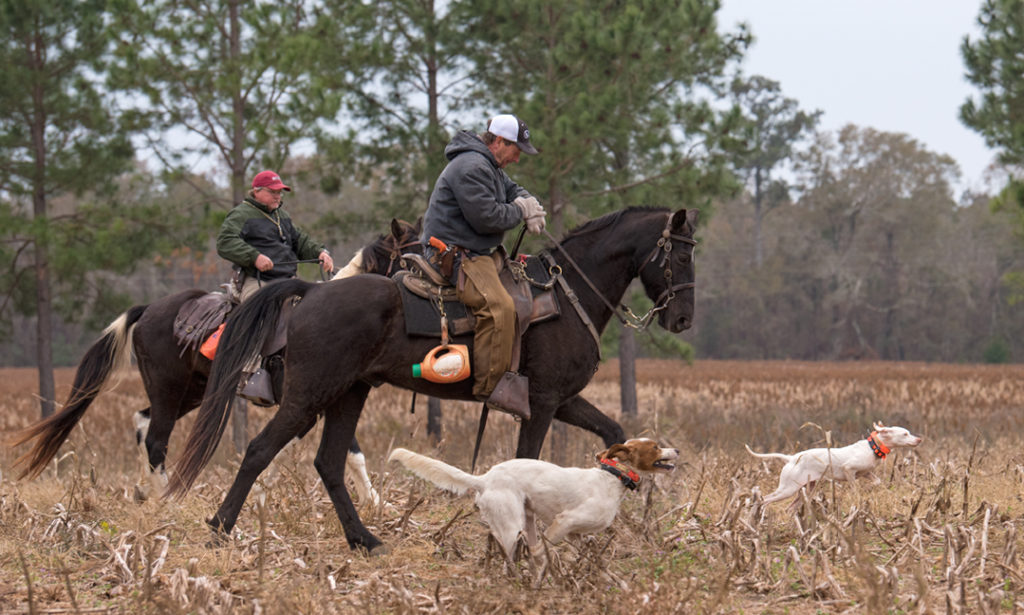Field trials for pointing dogs began in North America in 1874. They had begun first in England in 1865. The form of trials here have long followed a simple format: entries are submitted, their names written on slips of paper, the slips folded and placed in a receptacle, then drawn out two by two as bracemates. Then braces are run for a prescribed time over a prescribed course.
Handlers are mounted on horseback as are judges (two or three), and observers called the gallery. Each handler is allowed a mounted helper called a scout who must ride behind the judges whose job it is to find the dog pointed or guide it back on course. There are also walking-handler stakes.
Ideally the bracemates hunt for upland birds ahead on the course (sharptails, huns or pheasants on the northern prairies, quail below, chukars in the mountain west, ruffed grouse in the Lake States, New England and Pennsylvania where handlers walk). The dogs seek and point the birds, remaining frozen at their flush, when the handler signals success by firing a blank.
The judges decide winners (first, second and third or Champion and Runner-Up) on a subjective, unstated standard devotees come to understand, though they often disagree with particular decisions. In open stakes (where most handlers are professionals who charge owners to train and handle) modest purses raised from entry fees are awarded. In amateur stakes handlers are not paid or purses awarded and most handle dogs they or friends own just for the fun of it, and fun for them it is!
How is the sport regulated? Open stakes are sanctioned by a privately owned company called the American Field Publishing Company or the Field Dog Stud Book which registers and keeps pedigree records of pointers and English setters and sets minimum standards for trials and announces what trials it will recognize as Championships. It requires notice be published in its weekly journal of upcoming trials. It is and has been since 1874 a monopoly, though mostly a benevolent one. It makes modest money from dog registration and pedigree fees and advertising. Amateur stakes are sponsored and regulated by an oversight membership organization called the Amateur Field Trial Clubs of America.
The American Kennel Club also sanctions trials, horseback and foot-handled, run under its rules for dogs it registers, many for specific breeds.
For American Field Trials there are two so-called major circuits, classified as All-Age (widest ranging) and Shooting Dog.
A National Championship stands as the crowning goal for All-Age dogs and has run most years in February since 1896. The Ames Plantation at Grand Junction,Tennessee has long been its home. Entries are limited to about forty dogs that have won two first places in hour-brace stakes. Heats are three hours. To win the National Championship is the brass ring for every All-Age pro handler and owner, and getting a dog qualified for it dictates much of how the sport functions, for better and worse. For Shooting Dogs a comparable National Championship with 90-minute heats serves as fulcrum.
Purina uses a points system based on numbers of competing dogs beat in competition through a season (Fall to Spring) to recognize Top Dogs in the All-Age and Shooting Dog categories, Open and Amateur, and these awards are hard fought for and coveted.
Through the decades, trials have faced and survived many challenges: depressions, recessions, wars, widespread loss of wild game, constantly rising costs, resulting in poor economics for trainer-handlers who even when successful earn little, shrinking trial venues and training grounds made available by private owners and government agencies.
Traditionally, trials are sponsored annually by clubs, often anchored by a wealthy landowner who loves the game. But they are mortal. So, for example, the National Free-For-All Championship, the other three-hour-heat Open All-Age Championship, long a rival of the National, passed into oblivion with the death of its mentor, though it has been nominally revived as a 90-minute heat contest.
So how and why has the sport survived?
Because a great bird dog has an appeal to Field Trialing’s True Fans that is for them irresistible. The ranks of those who learned this in childhood following a father’s or uncle’s dog on foot on a farm is mostly gone. But enough others in the sea of humanity have learned it — for now — to fill the thin ranks of The Faithful. (Trialing has never been a sport for the masses, just for a few).
Who breeds and develops these great dogs? Like thoroughbreds, they come from a narrow gene pool of individual sires and dams that have been proven by competiton to possess the necessary athletic ability and intelligence to excel. A few devoted breeders, one in particular now eighty five years old, have lead this effort. Ironically, this man did it for the money, he will tell you straight out. He is about the only person in the history of the sport to make money in it. In contrast, thousands have spent fortunes pursuing it for pure pleasure.
Yes, it is the thrill and excitement a truly great dog can inspire in a man or woman of a certain temperament that has kept field trials alive against all odds. May the Thrill of the Hunt, anchored in a dog’s and humanity’s shared primal urge, continue to hold Field Trialing together.

Tom, very nice work! I think there is a typo error here:
“have been proven by completion to possess”
Shouln’t “completion” be “competition” ?
Nice catch Bob…thanks!